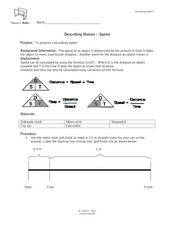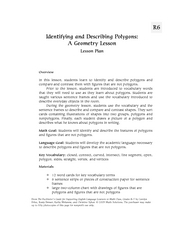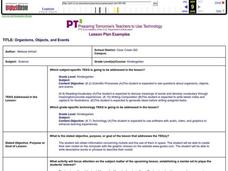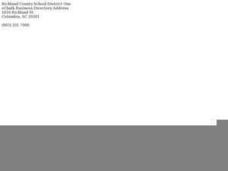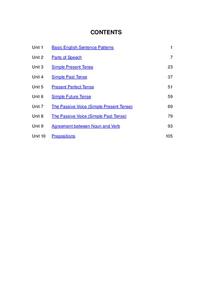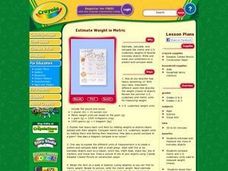Curated OER
"Teaching with Material Objects" - Horn-book
Students explore language arts by creating Venn Diagrams. In this reading materials lesson, students examine a horn-book and create a hypothesis about how to use it and where they derived from. Students compare their horn-book to a text...
Curated OER
Observing Objects
Students observe the motion of both a pendulum and a spring pendulum . They then explain the differences and the similarities between the two types of motions.
Curated OER
Describing Motion-Speed
Students study speed and learn how to calculate it. In this investigative lesson students participate in an activity that shows them how to calculate speed then they fill out a worksheet.
Curated OER
Moving Objects
Students discover the history of the United States by examining the Great Migration. In this U.S. History instructional activity, students research the immigration movement on the Internet and complete a worksheet about the large...
Curated OER
Identifying and Describing Polygons
Students identify the different properties of polygons. In this geometry lesson, students differentiate between polygons and non-polygons. They review important vocabulary to help them understand the properties of polygons.
Curated OER
Describe and Classify 2-D Shapes
In this 2-D shapes worksheet, students match a set of descriptions to shapes given. A reference website for additional resources is given.
Curated OER
Organisms, Objects, and Events
Students obtain information concerning rockets and the use of them in space. They create their own rocket on the computer with the graphic choices on the website www.goobo.com. They write descriptive phrases about their rocket.
Curated OER
Classifying Living and Non-Living Objects
Students investigate living organisms and define the properties of a living species. For this life characteristic lesson, students examine plants in their class and discuss whether or not they are alive. Students create a...
Curated OER
Describing the Motion of a Battery Powered Cars
Young scholars explore distance a toy car travels by changing the amount of batteries used to power the toy car. In this force and motion lesson, students calculate the average speed of a car while investigating the power from...
Curated OER
Describing the Physical World
In this physical world worksheet, students review concepts relating to the chemical and physical properties of matter, density of matter, and if matter is a solid, liquid, or gas. This worksheet has 9 terms in a word puzzle, 4 true or...
Curated OER
Basic English Sentence Patterns
A simple set of practice sheets deals with sentence structure and patterns. The 117-page packet includes 10 units of skills, varying from identifying parts of speech in a sentence to writing the correct part to make a sentence...
Curated OER
Understanding Paragraph Basics
Full of informative, helpful, and accessible activities, a language arts packet is sure to be a valuable part of your writing unit. It's versatile between reading levels and grade levels, and focuses on the most efficient ways for your...
Center for Learning in Action
Properties of Balls
Enhance your states of matter lessons with a hands-on science investigation that compares six different balls' color, texture, size, weight, ability to bounce, and buoyancy.
Center for Learning in Action
Introduction to the States of Matter
Liquids, gases, and solids are the states of matter in which scholars investigate in a lesson plan that offers in-depth information and engaging activities that look into the three states and the changes their properties make when mixed...
Curated OER
Net "Working"
Upper elementary and middle schoolers explore the properties of various polygons. They use video, resource links, and engage in hands-on activities in order to construct geometric nets. This fine plan should lead to increased...
Curated OER
Estimate Weight In Metric
Students brainstorm words that describe the weight of objects. They pick up objects and estimate the weight. Afterward, students find the exact weight and compare U.S. units of weight to metric units. In groups, students create a chart...
Curated OER
Matter And Materials
Students investigate the concept of identifying different objects in nature and classifying them into different categories. The students will describe and explain a group of the objects orally and in writing form that is appropriate to...
Curated OER
What Came From Where?
Young scholars research patterns and networks of economic interdependence. They work cooperatively to create 3-dimensional representations of common objects and charts describing the objects' components and countries of origin. Students...
Curated OER
Craft Revival: Shaping Western North Carolina Past and Present
Students gain an understanding of a resident's lifestyle of North Carolina. They analyze five objects the are representation of the culture of North Carolina. Critical thinking skills are used to describe the geography through using the...
Curated OER
Pass It Down
Students in varying grades work cooperatively to create a living museum of items that have been "passed down" through generations. They give a brief oral presentation showing their object (or a picture of it) and describing its history...
Curated OER
Using Numbers Everywhere
Kindergarteners explore various representations and uses of numbers to develop number sense. They participate in an activity and arrange patterns into groups. Students compare the sets and describe the objects in each set.
Curated OER
ROV Grid Search
Pupils perform activities to recreate the exploration of the sea bottom. They attach magnets to the bottom of the remote controlled car to see how many camouflaged objects it can pick up. As a class, students examine the results of...
Curated OER
Eyes That Talk
Students explore their personal strengths and characteristics and write a short description of themselves. Afterward, they create a dramatic self-portrait with an expression that identifies who they are. Students fill the areas around...
Curated OER
Shaping Up With Picasso
Learners examine the artwork of Pablo Picasso and describe geometric shapes they observe. After observing geometric pictures and other objects, students create replicas of them using geometric shapes. Using a watercolor wash, learners...


